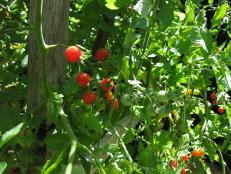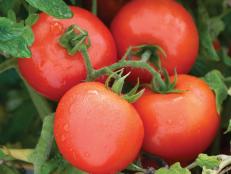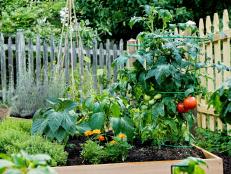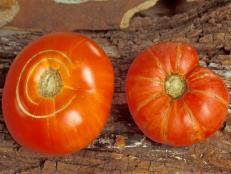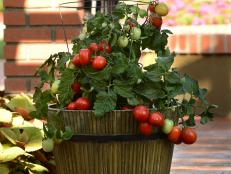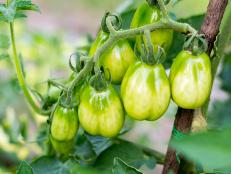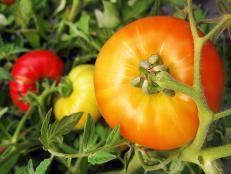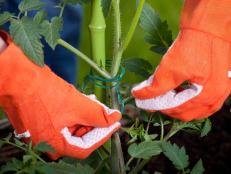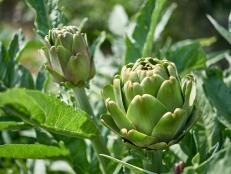Best Tomato Varieties for the South

Photo courtesy of Bonnie Plants
The tomato is hands-down the home gardener’s favorite plant to grow. Everyone who loves tomatoes knows that the fruit on grocery store shelves doesn’t have true tomato flavor. Even people who don’t normally garden will grow a few tomato plants in their landscape. Some grow them in front or backyard borders while others plant tomatoes in large containers. It’s always a race in my neighborhood to see who can get a ripe tomato sliced and on the menu by Independence Day.
How do you choose tomatoes that grow best in the South? It takes a bit of savvy to know the best varieties and techniques to succeed with tomatoes in a climate that is very hot in summer and unpredictable in spring.
As with all garden endeavors, choosing the right variety is the first and foremost way to succeed whether you’re considering roses, apples, tomatoes, or any other plant. Choose tomato varieties that love hot weather and are disease resistant for best results. Also pick varieties that are early bearing, along with those that are main season because you never know what the weather will bring.
Hybrid tomatoes, which are controlled crosses of two parent plant varieties, are not the same thing as genetically modified plants (GMOs), so rest easy if you choose a hybrid tomato. Many hybrids are bred specifically to build in heat and disease resistance.
Look for the initials V, F, N, T, A on tomato plant labels. These indicate the tomato is resistant to:
- Verticillium wilt;
- Fusarium wilt;
- Nematode disease;
- Tobacco mosaic virus; and
- Alternaria.
These are the top five, but there are additional viruses, so you may see even more initials on the label, including:
- BCTV for beet curly top virus resistance;
- SMV for tomato spotted wilt virus resistance; and
- LB for late blight resistance.
As you can see, tomatoes suffer from a variety of diseases and pests, so it’s important to get ahead of these whenever possible.
Throughout the Northeastern U.S., late blight—the same disease that started the potato famine in Ireland in the 19th Century—has plagued tomato growers. Hybridizers responded with several tomato hybrids resistant to late blight. One of these is called ‘Defiant'. So far, late blight hasn’t been as much of a problem in the South, but all gardeners should always be on the watch for it and early blight.
Two of the varieties bred specifically for hot weather are: ‘Heatmaster’ and ‘Mountain Magic'. Because hybrids don’t breed true, you can’t save seed from them like you can with heirlooms or other open-pollinated varieties.
Tomato Varieties for the South
See All PhotosHybrids aren’t the only answer for Southern gardeners though. Some heirlooms grown in the South are very productive. Buy plants locally from an established farmer or nursery to get those adapted to your climate and area.
Heirloom Tomatoes
Heirlooms are open-pollinated plants grown from seed saved by gardeners and farmers. Often heirloom tomatoes have interesting pedigrees and romantic histories. Some don’t perform well in Southern gardens while others are tried and true. Research before you choose an heirloom tomato for your garden. If you’re starting seed, choose seed saved in a climate similar to yours. If you’re starting seeds indoors, try one of the Southern seed exchanges like Southern Exposure Seed Exchange, or other seed companies that collect seed from gardens throughout the South. You can also get seeds from swaps in your neighborhood, or from other gardeners you know and trust. Garden clubs often have seed and plant fundraisers in the spring. Perhaps you also have a local tomato grower in your area like The Tomato Man’s Daughter in Tulsa, Oklahoma. Every year, Lisa Merrell saves seed from her tomatoes and sells plants of open-pollinated varieties of tomatoes and peppers. She also compiles a list of heirlooms that performed well in her garden the previous year. Choosing heirloom tomato plants grown in your area insures greater success. Open pollinated varieties I’ve grown successfully are: ‘Black Krim', ‘Cherokee Purple', ‘Lumpy Red’ and ‘Homestead 24'.
Most heirloom tomatoes are indeterminate, and many hybrids are determinate. What’s the difference?
Determinate vs. Indeterminate
Determinate tomatoes are often called “bush type” because they grow smaller and bushier than indeterminate types. Once fruit sets on the bloom, determinate tomatoes put all of their energy into it. Determinate tomatoes yield most of their crop over a period of two to three weeks so you’ll get a large number of tomatoes all at once. Because their growth habit is about 3 feet tall to 3 feet wide—unless you have a patio-type hybrid, and then it will be smaller—you can cage determinate tomatoes. Determinate tomatoes are often better for smaller gardens.
Tomato cages don’t work well for indeterminate tomatoes because their growth is long and lanky. They grow and produce throughout the season and can get up to 6 feet or taller with some varieties. You will need to stake them in order to keep them tidy, or you can build larger and heavier cages. Don’t let their lankiness deter you from trying indeterminate tomatoes. They can have more complex flavors because they are often heirlooms that have developed over years of saving seed.
When choosing your tomato varieties, remember that good tomatoes don’t necessarily need to be red. Tomatoes come in a variety of colors and tastes including purple like ‘Indigo Rose’, yellow/orange like ‘Sungold’ or ‘Snow White', green like ‘Green Zebra’ and even pink like ‘Brandywine'.
A word on storage—never store tomatoes in the refrigerator because cold stops the ripening process. Always store tomatoes at room temperature, and if you have too many to eat at once, give them away, or preserve them via freezing or canning.






